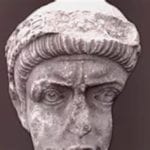 Weird Stuff
Weird Stuff  Weird Stuff
Weird Stuff  Mysteries
Mysteries 10 Tragic Disappearances and Deaths in Joshua Tree National Park
 History
History 10 Ways Childhood Really Sucked in the Old West
 Music
Music 10 Name Origins of Famous Bands from the 1990s
 Religion
Religion 10 Biggest Turnarounds by the Catholic Church
 Weird Stuff
Weird Stuff 10 Unbelievable Times Laws Had Unintended Consequences
 Humans
Humans Ten Historic Women Who Deserve Way More Credit Than They Got
 Movies and TV
Movies and TV 10 Films That Spawned Major Lawsuits
 History
History Ten Times Towns Were Wiped Off the Face of the Earth
 Creepy
Creepy 10 of the Most Disturbingly Haunted Public Houses in the UK
 Weird Stuff
Weird Stuff 10 Niche Subcultures That Are More Popular Than You Might Think
 Mysteries
Mysteries 10 Tragic Disappearances and Deaths in Joshua Tree National Park
 History
History 10 Ways Childhood Really Sucked in the Old West
Who's Behind Listverse?

Jamie Frater
Head Editor
Jamie founded Listverse due to an insatiable desire to share fascinating, obscure, and bizarre facts. He has been a guest speaker on numerous national radio and television stations and is a five time published author.
More About Us Music
Music 10 Name Origins of Famous Bands from the 1990s
 Religion
Religion 10 Biggest Turnarounds by the Catholic Church
 Weird Stuff
Weird Stuff 10 Unbelievable Times Laws Had Unintended Consequences
 Humans
Humans Ten Historic Women Who Deserve Way More Credit Than They Got
 Movies and TV
Movies and TV 10 Films That Spawned Major Lawsuits
 History
History Ten Times Towns Were Wiped Off the Face of the Earth
 Creepy
Creepy 10 of the Most Disturbingly Haunted Public Houses in the UK
Ten Amazing Artists Who Were Horrible Humans
You don’t need to be a good person to make good art. Those two things have no connection, of course. Plenty of good people can’t make worthwhile art at all! And plenty more artists aren’t great people when it comes to interacting with friends, family members, and strangers. This shouldn’t really come as a surprise. After all, artists are just like other people—their personalities are broadly similar to those you’d find among a large cross-section of accountants, doctors, janitors, plumbers, or professors.
But with artists, the question of supporting their work comes into play, too. Is it possible to enjoy a piece of art if the person who made it was a horrible person? Could you appreciate a brilliant painting if you knew it was produced by a child abuser, or relish a piece of music if you learned it had been composed by a virulent racist?
We’ll try to answer that question today. In this list, you’ll learn about ten world-famous artists who were actually terrible human beings. In the public eye, their works are still celebrated the world over after decades—and sometimes centuries. But in their private lives, these men were less than kind to loved ones, family members, colleagues, and friends.
Related: 10 Artists Who Destroyed Their Own Work
10 Michelangelo Merisi da Caravaggio
It’s such a common phrase by this point to be nearly meaningless when you hear someone can supposedly “get away with murder.” But famed Renaissance painter Michelangelo Merisi da Caravaggio actually did get away with murder in his life. And he went right on painting through it.
Caravaggio is best known for his exquisite oil paintings depicting gory scenes and bloody battles. His subjects show remarkable motion on the canvas while slaughtering and getting slaughtered. And as it turns out, Caravaggio’s paintings may have very much followed a murderous trend in the artist’s own life.
Art historians have long made note of Caravaggio’s drinking habits. He was very well-known during his raucous life for getting drunk in Italian bars and pubs and then assaulting anyone within arm’s reach. Some historians even assert he was a well-known pimp who sold a series of women to local johns. His worst sins were far more deadly, though. As a teenager, he reportedly killed a man in his hometown and was forced to flee. A few years later, he murdered a young male rival of his on a tennis court and skipped his adopted hometown once more.
Historians believe he killed several more people across Italy. His hard-drinking habits certainly didn’t help. But it’s not every day that a world-famous painter is also supposedly a serial killer. In the end, the law caught up with Caravaggio. Government officials in the Papal States soon grew tired of his violent ways. They put out a “bando capitale” on the artist. Basically, it allowed any local resident the opportunity to catch and kill Caravaggio as an enemy of the state.
In 1610, the Knights of Malta caught up to the painter and gave him a taste of his own medicine. As we know now, the world lost a phenomenal painter when Caravaggio was killed. But at the time, the Papal States simply couldn’t stomach the pressure he put on society any longer than they already had.[1]
9 Paul Gauguin
Paul Gauguin’s most famous achievement—other than his own paintings, of course—was being the guy who chopped off Vincent Van Gogh’s ear. The two painters were longtime friends who shared costs and often made art based on the same subjects. They both had incredible eyes for color, shading, and style. And they both were difficult to work and live with, so their friendship was fated to end long before it probably should have. After his falling out with Van Gogh, Gauguin fled to French Polynesia and experimented with color in ways painters never before had done.
But that’s not what makes Gauguin unique for the purposes of this list. Instead, the post-Impressionist is known first for abandoning his French wife and five children upon leaving abruptly for Tahiti. Once he got there, he then started taking Polynesian children as brides.
By 1891, when Gauguin was in his 40s, the artist had taken three child brides younger than 14 years old. He had children with all three. Then, he promptly infected all three with syphilis, as well as spreading the virulent virus all around the island while having other trysts on the side. By the time he died in French Polynesia in 1903, his passing was welcomed by all the women whose lives he’d changed forever.[2]
8 Edgar Degas
Edgar Degas was one of the greatest Impressionist painters of all time. The talented artist was a living legend during his life in France. The way he depicted movement on canvas changed how many future painters saw the craft. But as it turned out, Degas was not the nicest person away from his art studio.
Deags’s behind-the-scenes controversies began in 1894, when a French Army captain named Alfred Dreyfus was convicted of selling military secrets to Germany. Dreyfus was Jewish, and the treasonous affair was big news in France at the time. (As it would later come to pass, it turned out Dreyfus was framed—but that mattered little to many people intent on criticizing him.)
Degas was one of many French citizens shocked to learn Dreyfus had supposedly been selling state secrets to a rival. But instead of just being mad about treasonous corruption, the Impressionist took things quite a bit further. Lamenting Dreyfus’s alleged behavior, Degas became a rabid and publicly vicious anti-Semite.
The artist began to loudly proclaim to anyone who would listen—and many who wouldn’t—that all Jews were just as bad as Dreyfus, and none of them could be trusted. Degas took things further, too, by cutting off all contact with any Jewish people who had been in his life. Sadly, that included dumping a lifelong friend who had never wronged the painter in any way.
In time, Degas’s anti-Semitism even bled into his work connections. The artist had previously loved the painting of Camille Pissarro, who was, then and now, the only major Jewish Impressionist of note. But after 1894, Degas refused to have anything to do with Pissarro. When a friend pointed out that Degas used to loudly support the Jewish artist’s work, Degas coldly replied, “That was before Dreyfus.”
As the calendar turned to the 20th century, Degas’s anti-Semitic streak continued. In one notably bizarre incident, he kicked a model out of his studio for being Jewish—even though she was actually a Protestant. If there’s any consolation to Degas’s cruel behavior, it’s that his friends had all mostly abandoned him by the time of his death in 1917. They had grown weary of his constant racist attacks and diatribes.[3]
7 Richard Prince
Richard Prince has what every modern-day artist seemingly wants. He’s an in-demand star with work that sells for millions of dollars. He’s esteemed by colleagues, and his work is desired by art buyers worldwide. In 2015, one art publication even named his work some of the most lucrative pieces among all living artists. There’s just one little problem with it all: He keeps getting criticized—and sued—for ripping off other people’s art.
In 2014, Prince held an exhibition of photos he simply copied off Instagram. That was it. That was the art. He pulled other people’s digital photos off Instagram, printed and framed them, and then sold the images for a whopping $100,000 each. He didn’t even tell the original photographers!
When word got out, and the original photographers started getting mad about their images being used without warning or compensation, Price whined about how the “phony fraud photographers” simply couldn’t stop “mooching” him for recognition.
But Prince’s story gets weirder still. In another photo grab, the popular artist swiped and repurposed nearly three dozen images from photographer Patrick Cariou. The French photographer had published them in a book about Jamaican men titled Yes Rasta.
Prince liked them so much that he copied about 30 of the images, drew electric guitars on them, and sold them all. He netted millions of dollars in profit—and a lawsuit from Cariou. That court battle has dragged on for years with stops, starts, decisions, appeals, and rulings. One thing is for certain, though: photographers rightfully don’t seem to care too much for Richard Prince’s antics.[4]
6 Benvenuto Cellini
Italian sculptor Benvenuto Cellini is still known today as one of the foremost goldsmiths of history. He mashed and molded gold into incredibly detailed and intricate sculptures. He created the still-iconic Cellini Salt Cellar and a famed sculpture of Perseus with the Head of Medusa. He even wrote a painstakingly detailed autobiography that historians still point to as one of the foremost literary works of the 16th century.
But away from his art and literature, Cellini was—to put it in the mildest terms—a bad dude. The sculptor’s rough life began very early. As a teenager, he brawled so much that he was cast out of his hometown. Living his young life on the road only made Cellini more vicious, though. He started carrying knives and was known to pick violent fights with foes, real or perceived.
Then, in 1527, the Sack of Rome happened, and Cellini saw his first taste of real murderous action. He killed at least two of the occupying soldiers in a rage during the invasion. And he apparently enjoyed it so much that he chose to keep killing after that.
Over the rest of his life, Cellini killed at least three more men and wounded several others. One of his brothers was executed by police in Florence because of a murder he’d committed—thereby proving the vicious familial connection. Benvenuto didn’t like that his brother had to die, though, so he killed one of the watch’s corporals in revenge.
A few years later, he was busy beating a man to death when a witness saw him do it and turned him in. Cellini promptly killed the witness before the man could testify against him. A few years after that, Cellini went to sculpt in France. There, he became the subject of a civil lawsuit. But before that filing could work its way into court, Cellini crippled the plaintiff’s legs and fled town.
The murderous man faced no long-lasting consequences for these acts and lived just short of his 71st birthday before dying peacefully in 1571. His art lives on today—and his horrific and violent acts now do, too.[5]
5 Eric Gill
Eric Gill used his talents as an incredible sculptor. During the early 20th century, he was one of the foremost progenitors of Britain’s powerful Arts and Crafts movement. Gill’s work is known the world over, and it sits in some high-profile places.
At times, his sculptures have sat in front of the BBC’s Broadcasting House in London, as well as the United Nations’ European headquarters building. Many of his works are meticulously guarded as part of careful collections by London’s Tate Galleries. And many more of his famed pieces are very much inspired by the solemn and powerful Catholic faith.
But Gill himself was a star-crossed person in his private life—to say the very least. According to art historians, Gill seduced at least one of his sisters during his lifetime, with some contending he actually slept with both. He conducted unspeakable sexual and physical experiments on his family’s pet dog late at night for years. And it later came out that he sexually abused his daughters throughout childhood and their teenage years.
Gill was often sick in his adult life; in 1940, he passed away after battling lung cancer. He wasn’t even 60 years old. And for a while, nobody knew about his sordid personal dealings. Those shocking revelations only came out five decades after his death, when a jaw-dropping biography was published about the real Eric Gill.[6]
4 Francis Bacon
Francis Bacon delivered shocking and often gruesome portraits of characters throughout his prolific art career. The 20th-century Irish artist—not the 16th-century English statesman—was known for painting revolting images of nearly inhuman people doing unspeakable things. As it turned out, in his case, at least, life imitated art. Or maybe we have that backward, and Bacon’s unsettling art actually imitated his dark life.
The Irish-born artist was a very disturbed individual who was said to have pushed several boyfriends into such despair that they committed suicide. He also viewed sexuality as an opportunity to “prey” on younger, often unwitting victims. When he was just a teenager, a stablehand was said to have tied him up and whipped him while bound. That may have affected the rest of Bacon’s life, as he soon became a sexual predator in revenge.
In 1963, Bacon met London-born male model George Dyer at a pub. The two men hit it off—well, as easily as one could with Bacon—and soon began a torrid affair. But it was tempestuous from the very beginning. Both men physically harmed each other in an endless loop of domestic violence. Bacon was twisted enough to emotionally do damage to Dyer’s fragile psyche, too. In 1971, the awful relationship came to a head.
While on a trip to Paris, Bacon embarrassed and then cast away Dyer. The emotional pain was so great that the male model killed himself in response. For his part, Bacon lived out the rest of his days seemingly unbothered by Dyer’s shocking death at just 33 years old. The tortured (and torturing) artist lived out a long life beyond the suicide and died at the ripe old age of 82 in 1992.[7]
3 Percy Grainger
Percy Grainger was “Australia’s first great composer.” Okay, so that’s what he called himself. And can you really give yourself a nickname—or an honorific like that? The fact that Grainger bestowed such a moniker upon himself probably should have given the world its first clue that he maybe wasn’t the kindest person out there. Then, throughout his life in the first half of the 20th century, he pretty much proved those suspicions correct.
Even though he was born Down Under and theoretically far away from much Jewish interaction taking place in Europe, Grainger still took great interest in the faith. And not in a good way. His entire life’s work, from music to his social commentary and public persona, centered on some deeply and very strongly held anti-Semitic beliefs.
And when his professional attention turned to preserving and promoting classic British folk music, he did so for a disturbing reason. Grainger believed Britain’s white natives were at risk of losing their “creative genius” due to immigration, race-mixing, and Jewish conspiracies.
Grainger lived in the United States from the mid-1910s on, and his life played out during a tumultuous few decades in American history. For much of that time, he drew on prior years he’d lived in Germany to enthusiastically support the work of Nazi Party favorites. One of the men Grainger held in the highest esteem was a British-German philosopher and pro-Nazi thinker named Houston Stewart Chamberlain, whom Grainger believed to be the world’s foremost academic.
When World War II broke out, Grainger’s old German friends asked him to help Jews who were fleeing the Nazi regime. He turned them down again and again despite having the means and connections to help. Not great, Percy.[8]
2 Bob Kane
Bob Kane spent his life claiming he invented Batman. In reality, one of his longtime friends, Bill Finger, created the Caped Crusader. And even worse, not only was Finger left uncredited with the creation for decades, but Kane also seemed to take any and every opportunity to rub it in his face. Batman took off in the late 1930s, of course. But it wasn’t actually Kane’s own creation—at least not as the superhero ended up being portrayed.
In the middle of the Great Depression, Kane started thinking about a superhero named Bat-Man. Kane wanted the star to have a red suit and wavy blonde hair. He was supposed to fly around using a pair of attached bat wings, too—hence the name. So Kane enlisted his artist friend Finger to make a mockup design of the new hero.
Quickly, Finger realized the whole concept behind Kane’s Bat-Man idea was laughable. Dumping the bright red costume and wavy blond hair, Finger instead put the superhero in a black, skin-tight suit. Finger also dropped Bat-Man’s various superpowers, turned him into a detective, and gave him Bruce Wayne’s backstory. Finger even created other mainstay characters like Catwoman, Robin, and the Joker to help fill out the tale.
Kane loved the idea and ran with it, but he didn’t care to bring Finger along for the ride. After his unlucky friend was done creating characters, Kane took the mockups to DC Comics and secured a contract that specifically did not mention or include Finger in any way. The rest, as they say, is history.
Finger died in obscurity years later, having been unable to receive any credit for his work. Kane made money off Batman from the very start of his lucrative partnership with DC. Still, Finger never got a dime in royalties. He didn’t even get a creator credit on the iconic idea until 2015—long after he passed away in 1974 after years of heart problems.
As for Kane, he died a rich man in 1998. His gravestone acknowledged that he did have a little help in creating Batman after all. But the credit didn’t go to Finger; instead, it claimed “God” assisted Kane in creating iconic comic books.[9]
1 Pablo Picasso
If you know anything about Pablo Picasso, you’re probably surprised that you had to wait this long to see his name pop up. The painter is arguably the most talented visual artist to ever live. Certainly, he’s one of the most famous. His name is synonymous even today with works of beauty, splendor, and uniqueness.
But away from his public life, Picasso was a troubled and often very demanding man who put his family and friends through hell. “He needed the blood of those who loved him,” Picasso’s granddaughter Marina once famously said about the artist. Sadly, that very often proved to be true.
Picasso himself didn’t try to hide this fact about his personality. He once called women “machines for suffering” and boasted about being the one to push them to their limits. Even though he made lots of money during his life, Picasso never let his loved ones partake. After Marina’s own parents split up, Pablo ensured the little girl and her mother remained in abject poverty. He intended to “teach them a lesson” with the cruel and unnecessary act.
Things could have been worse, though. For decades, he mistreated women in relationships with constant infidelity and relentless verbal and emotional abuse. Of the half-dozen women who featured significantly in Pablo’s life, two were driven to madness and institutionalized, while two more died by suicide.[10]








